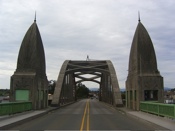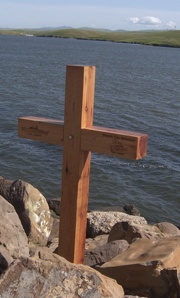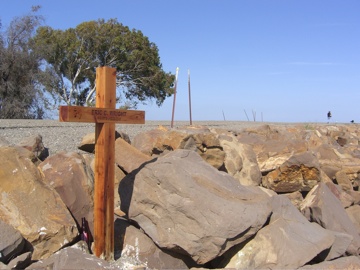The world is, per custom, full of more serious issues and worthier subjects in my life and others, but sometimes you just have to put all that aside and complain. Listening to one of my several daily fulminations on diverse subjects, Kate said, “You should have your own show–‘This American Gripe.’ ” I like the idea well enough, but so far it hasn’t gone further than that (although I will note that as of this writing the exact phrase “this American gripe” appears exactly once in Google’s database and that thisamericangripe.com is still available).
So, This American Gripe. Here’s one:
I mentioned recently that I got a call from someone in Oregon who wanted to use a picture that I took last year. Kate and I, with dog in tow, drove up to Eugene over Memorial Day weekend, picked up Thom and drove over to Florence, on the coast. A beautiful arched lift bridge carries U.S. 101 over the Siuslaw River there, and I took some pictures of it.
OK, then. I got a phone call about 10 days ago from a woman named Nancy who works for the Harley-Davidson dealership in Coos Bay, well down the coast from Florence. The town has a rhododendron festival, and the Harley place is making up a special T-shirt for the occasion. Nancy said they liked one of the pictured I took and wanted to use it as part of the T-shirt design. I was flattered. Naturally, I said they were welcome to do so; I just asked for a couple of the T-shirts in return for sending them the highest resolution version of the picture I had.
Since I had taken several bridge pictures that I put online, I asked Nancy to describe the one she wanted: It was an image that was obviously taken in the middle of the roadway with one of the bridge arches in the foreground and a car visible far down the road. From the group of shots I had taken, only one fit that description and I emailed the original to Nancy. I remarked that it looked a little darker than the online version of the shot; she agreed and asked whether I had a brighter version; I adjusted the brightness and contrast and color qualities of the picture and sent two more versions for Nancy to compare.
Then she said that the shot I sent her seemed to have been cropped–that the one she was looking at appeared to have been taken a little farther out from the bridge structure than the version I’d sent. I checked to see whether I had cropped the original. Nope. But at this point I suspected that we were not talking about the same picture at all and asked her to send me a copy. She did, and here it is (left–hers) side by side with the original (right–mine).
Well, they are pictures of the same bridge. But if you asked for a copy of the one on the right, and someone sent you the other one, would you think for even a moment that they were the same picture? No, you wouldn’t. For her part, Nancy seemed reluctant to believe that the picture she had wasn’t my work, even after I told her it wasn’t.
Next time, I suppose the smart thing to do would be to ask for a copy of the picture in question before I start trying to hunt for something I don’t have.
Technorati Tags: oregon




